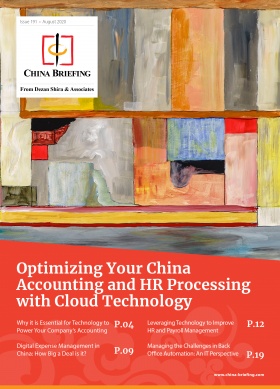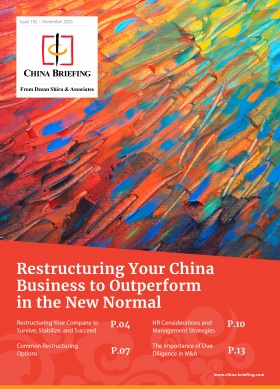CIIE 2020: China’s Market Openness to Foreign Enterprises
The third edition of the China International Import Expo (CIIE), the first dedicated import exhibition in the world, was held in Shanghai, from November 5 to 10.
The CIIE, as remarked by the Chinese president Xi Jinping during the opening ceremony, demonstrates China’s desire to share its market opportunities with the world and contribute to the global economic recovery amid the COVID-19 pandemic.
What is the CIIE?
The CIIE was organized for the first time in 2018, from November 5-10, under the theme of “New Era, Shared Future”, aimed at strengthening the economic cooperation and trade, while promoting global trade and world economic growth. Since then, three CIIEs have been organized and the exhibition’s popularity continues to increase.
Previous CIIE editions
In 2018, the CIIE concluded with deals worth US$57.8 billion and the expo had over one million attendees hailing from 172 countries, regions, and international organizations; more than 3,600 enterprises participated in the exhibition.
After the first edition, even though the success of the CIIE was undeniable, foreign businesses and governments complained about the lack of implementation of the promised reforms about lowering tariffs, broadening foreign market access, and increasing imports from overseas.
Nevertheless, the second CIIE, held in 2019, concluded with US$71.13 billion worth of tentative deals reached for one-year purchases of goods and services. A total of 181 countries, regions, and international organizations attended the expo; more than 3,800 enterprises participated in the exhibition.
Considering CIIE’s positive trend and the intention of many companies to attend the third edition of the expo, China had high expectations for the CIIE 2020.
CIIE 2020: Highlights
Despite the pandemic, the third CIIE was able to go forward as a huge international economic and trade event. This time the event included both online and offline exhibitions, arranged to facilitate the epidemic prevention and control guidelines.
The expo’s total exhibition area was nearly 360,000 square meters (30,000 square meters larger than the previous edition) and four new zones for public health and epidemic prevention, energy conservation and environment protection, smart transportation, as well as sports goods and competitions were set up.
CIIE 2020 covered six major exhibition sections – including food and agricultural products, automobiles, intelligent industry and information technology, consumer goods, medical equipment and healthcare products, and trade services – and the number of top enterprises that participated surpassed that of previous editions. According to Sun Chenghai, deputy director-general of the CIIE Bureau, at least 411 new products, technologies, and services made their China or global debut at this year’s CIIE.
This year’s CIIE has been extremely successful and each sector had several visitors and important exhibitors:
- The food and agricultural products exhibition area had the highest number of exhibitors, counting 1,264 exhibitors from 93 different countries.
- The world’s top seven carmakers were all present in the auto exhibition area.
- The technical equipment exhibition area was dedicated to several companies from different sectors, such as automation, intelligent manufacturing, and industrial digitalization.
- The consumer goods exhibition area occupied more than 90,000 square meters, making it the largest exhibition area of the CIIE 2020.
- The service trade exhibition area brought together the world’s top companies in five major sectors, including finance, logistics, consulting, inspection and testing, and tourism.
- The medical equipment and healthcare exhibition area had the highest number of new products and technologies launched during the CIIE (with a total of more than 120 items) and the top 10 companies from both the pharmaceutical industry and the medical device industry participated in the exhibition.
This year, nearly 400,000 professional visitors attended the event, up to 70 percent of the world’s top 500 companies that participated in the first two expos were present at the third CIIE, and more than 400 new products, technologies, and services were launched.
The expo concluded with tentative deals worth US$72.62 billion reached for one-year purchases of goods and services, thus registering an increase of 2.1 percent over the previous session.
Moreover, hundred companies have already reportedly signed up to participate at the next edition of the CIIE.
Why CIIE matters to China and foreign countries?
Over the past three years, the CIIE has become a major platform for international procurement, investment promotion, and cultural exchange, mostly because, as the Chinese president Xi Jinping said “CIIE has enabled exhibits to become traded goods and exhibitors to spot more investment opportunities”.
The CIIE’s popularity in the international context is also due to the implementation of the measures previously announced – concerning tariffs, foreign market access, and increase imports from overseas.
Among the measures adopted by the Chinese government, it is worth remembering the shortening of the negative list for foreign investments from 40 to 33 items, the increase of pilot free trade zones from 18 to 21, the Master Plan for the Development of Hainan Free Trade Port, and the Implementation Plan for Further Reform and Opening-up in Shenzhen – to mention a few – all of which have contributed to opening-up the market and creating a better business environment for foreign investors.
The 2020 edition of the CIIE, considering the hard time most countries are going through, played an important role in renewing international trade and investment relationships across the world – many of which were likely in limbo since the start of the pandemic. It was also considered by the Chinese organizers as an important occasion for the country to establish itself as a foreign investor-friendly destination and to contribute to the world economic recovery by promoting global cooperation and international trade.
Further, holding the CIIE is aligned with China’s dual circulation strategy, based on the principle of making domestic consumption the driver of economic growth while simultaneously promoting closer trade and investment relations with other countries to enhance and sustain long-term growth.
Through the CIIE, China offers a platform for Chinese consumers to access products from overseas markets, but also creates opportunities for foreign companies to explore the expansive Chinese market.
What foreign companies can expect?
The Chinese government’s aim is “to turn the China market into a market for the world, a market shared by all, and a market accessible to all,” and based on Xi Jinping’s speech, further measures will be implemented to ensure that access to the Chinese market is more liberalized.
More specifically, the Chinese president announced that:
- China will continue to leverage the pioneering role of pilot free trade zones and free trade ports in steering market opening-up and will introduce a negative list for cross-border services trade and open wider in areas like the digital economy and the internet.
- China will encourage cross-border e-commerce and other new business forms and models to grow even quicker to foster new drivers of foreign trade, and will shorten its catalogue of technologies prohibited or restricted from import to create a favorable environment for the free flow of technologies across borders.
- China will continue to make its foreign-related legal framework more open and transparent, and better protect the lawful rights and interests of foreign investors.
- China is ready to sign high-standard free trade agreements with more countries and will take an active part in WTO reform.
The above-mentioned measures are necessary. Despite recent reforms foreign investors in China still face many obstacles, primarily due to ambiguous rules and regulations, an unpredictable legislative environment, and market access barriers and investment restrictions. Reassurance in these areas will be essential for China to remain a favored destination for foreign investors.
About Us
China Briefing is written and produced by Dezan Shira & Associates. The practice assists foreign investors into China and has done so since 1992 through offices in Beijing, Tianjin, Dalian, Qingdao, Shanghai, Hangzhou, Ningbo, Suzhou, Guangzhou, Dongguan, Zhongshan, Shenzhen, and Hong Kong. Please contact the firm for assistance in China at china@dezshira.com.
We also maintain offices assisting foreign investors in Vietnam, Indonesia, Singapore, The Philippines, Malaysia, Thailand, United States, and Italy, in addition to our practices in India and Russia and our trade research facilities along the Belt & Road Initiative.
- Previous Article Belt and Road Weekly Investor Intelligence #3
- Next Article Chinas Einkaufsfestival Double 11 testet die Konsumkraft nach COVID-19


























